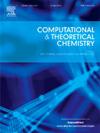Influence of external electric field regulating hydrogen adsorption on graphene quantum dots, graphene quantum dots with defects, and metal-ion-doped graphene quantum dots
IF 3
3区 化学
Q3 CHEMISTRY, PHYSICAL
引用次数: 0
Abstract
Hydrogen storage is crucial for efficient hydrogen energy utilization, but current materials often require extreme conditions, such as low temperatures (<20.15 K) or high pressures (350–700 atm), and an ideal adsorption energy between −0.2 and −0.6 eV. This study employs density functional theory (DFT) to explore hydrogen adsorption on graphene quantum dots (GQDs), including pristine GQDs, nitrogen-substituted divacancy defect GQDs (4N-GQDs), and metal-ion-doped 4N-GQDs (M-4N-GQDs, M = Ti2+, Fe2+, Cu2+, Zn2+). Pristine and 4N-GQDs show comparable adsorption energies (−0.02 eV), while M-4N-GQDs exhibit stronger adsorption, ranging from −0.221 to −0.025 eV. Ti2+-4N-GQD achieves an optimal adsorption energy of −0.221 eV, making it highly suitable for hydrogen storage. The metal center’s charge transfer upon hydrogen adsorption influences binding strength. An external electric field (EEF) further reduces adsorption energy, promoting H2 desorption. These results highlight Ti2+-4N-GQD’s potential for regulating H2 adsorption and desorption in hydrogen storage applications.

求助全文
约1分钟内获得全文
求助全文
来源期刊

Computational and Theoretical Chemistry
CHEMISTRY, PHYSICAL-
CiteScore
4.20
自引率
10.70%
发文量
331
审稿时长
31 days
期刊介绍:
Computational and Theoretical Chemistry publishes high quality, original reports of significance in computational and theoretical chemistry including those that deal with problems of structure, properties, energetics, weak interactions, reaction mechanisms, catalysis, and reaction rates involving atoms, molecules, clusters, surfaces, and bulk matter.
 求助内容:
求助内容: 应助结果提醒方式:
应助结果提醒方式:


